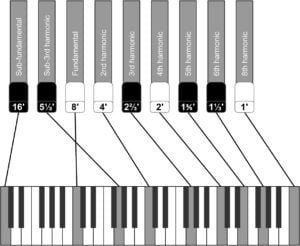Bobman107 has some very good instructional videos up on youtube that show how to remove the keyboard or manuals from the most popular Hammond consoles (B2, B3, C2 and C3).
Category Archives: Instruction
Hammond – Music To Live By
Brilliant Hammond informercial from the ’60s. Explains how important it is to have a Hammond organ in your home and how easy it is to play one. Features a H-Series Hammond. ‘Everything the family needs’.
Hammond B3 / C3 User Manual
Here’s a Hammond B3 / C3 User Manual in PDF format. The manual applies to both the B3 and the C3 equally, since the only difference in these models is the different cabinet. Much of it will also apply to the A-100 series Hammonds, which also have a power- and a reverb amp, not found on the B3 or C3, but use the same tone generator, pre-amp and other components as these models.
Hammond Organ Simple Fix for Sound, Percussion, Pops & Pings
A few simple things you can do to clean up corroded contacts and pots to get your Hammond organ running, especially if it has been sitting a while.
The Hammond Drawbars secrets revealed

The drawbars on a console Hammond (B3, C3 or A100 and variants) and the clone wheels can be a source of much confusion. They are also sometimes called tone bars, and they are used to shape the sound.
Each drawbar is marked with a number in feet. As an example, the first (brown) drawbar is marked 16′. This terminology is borrowed from pipe organ technology, where this number actually describes the length of the pipe that is used to get a certain tone.
Every drawbar has eight settings, which indicate how much of a particular drawbar’s tone is added to the final signal, with 1 being the softest, and 8 being the loudest. When the drawbar is pushed in all the way, no sound from this drawbar is used in the final sound.
On a console, you will have five groups of drawbars, two for the lower manual and two for the upper manual, each of which consist of none drawbars, and one for the bass, which has two drawbars.
Drawbar colours
There are three different colours on the drawbars, brown, white and black.
The fundamental, ‘core’ tone is created by the first white drawbar. The other white drawbars are octave intervals of the fundamental tone of increasingly higher pitched notes.
The brown drawbars are the two ones to the left, and these produce harmonics below the fundamental tone. The first brown Drawbar is the sub-octave of the fundamental Drawbar. It is “one octave” lower in sound. The second brown drawbar is the “sub-octave” of the third harmonic. Pulling the brown drawbars makes the tone deeper and fuller.
The black drawbars introduce dissonant harmonics, which serve to color the tone and give it character.
Lower manual settings
The lower manual can be used either for playing walking bass, or comping chords. For the former, 808000000 works really well; add more of the 2nd drawbar to get a heavier, more ‘growly’ tone. This setting is not ideal for playing chords on the lower manual, since this makes the sound often too muddy. 008800000 seems to work better for chords down below, or you can just play them higher up the keyboard if you want to switch between walking and comping.
It is often is suggested to turn off V/C when using a walking bass – I think it can work either way, depending on the mood of the song. You can also turn off the bottom rotor to get that ‘Memphis’ sound, which also works well with walking bass lines.
Using the Leslie
Using a Leslie efficiently and effectively can be quite challenge – to get the best result, you may have to adjust you drawbar settings to get the most out of your Leslie fast setting (or, alternatively, to tame it down). If you use the Leslie on fast on your typical Jimmy Smith setting (888000000 / 808000000), you will get a very limited, subtle Leslie effect, even with the rotors on fast; if you want the highs to swirl prominently, you will have to add the higher drawbars. To stay with the Jimmy Smith idiom, try 800000888 on fast, and you’ll see what I mean. You may have to adjust your playing style to get the most out of the more extreme settings.
Some players seem to like introducing some reverb before the Leslie to get a different sound, this is something to experiment with.
Dr. Lonnie Smith plays the Neo Ventilator
Lonnie Smith plays the original Neo Ventilator, in mono it seems.
https://www.youtube.com/watch?v=2Ff2xCYwAtA
On the portable side
On the portable side, here’s a nice video of the Elkatone 610, which I use if I want to bring a ‘Leslie’ out. Not quite the real thing, but spins the air just fine, and gives a much better 3D-effect than most simulators, especially the high rotor works very well. Crossover is different, and the lower speaker gets the full signal. Fits into the boot of my car, and works well with the hot output of a Nord C1.
Repairing an A-102 Hammond
Found some very useful images on the organ forum showing a number of repairs that were done to an A-102. Covered are the lifting of the manuals, replacement of a key, and many more repair instructions are available.
